- Messages
- 99
- Location
- Netherlands
Dear forummembers,
Some time ago I posted a thread on what I was thinking a new species. See http://apistogramma.com/forum/index.php?threads/what-can-you-say-about-these.12574/#post-70980
In the months passed the female died and did not produce any new young. The male has lived for the last months but today he jumped out of his tank and did not survive. Therefor the story of this species is complete; I have a photo of the female in alcohol and a photo of the dead male. I have also added a photo of the young of these fish (now 1,5 cm).
The reason for me to say it is a new species is because of these signs/markings:
- both male and female show an obvious black spot at the end of the dorsal fin close to back of the fish. The only known species with such a spot is norberti. Norberti has no high dorsal fins in the male (at least not as much).
- the female has no black under the chin (no sp. Blackchin)
- the female shows no horizontal stripes under the lateral band (no cacatuoides)
Other caracteristics:
- the head and and mouth of the male (and female) are big and wide
- for the male the lateral band is separated from the caudal spot, for the female and the F1 this is less obvious.
- the dorsal fin of the male is high and the tips are red
- the caudal fin of the male has two tips and both (upper more) are red
- the male has two horizontal lines under the lateral band, but in his normal dress he doesn't show them; female has none.
- the normal dress for the female is one sidespot and the dorsal spot (the last is less visible)
- the first 1/3 of the lateral line of the male disappears when he is dominant
- the fish are found close to Leticia together with eunotus, bitaeniata and sp. Kelleri
- the fish were found by a Dutch group, who were also the first to find sp. Kelleri. This species was the bycatch of Kelleri, but in the commercial shipments of Kelleri the species has not turned up yet..
I hope this gives a complete image of the species. At this moment I have (only) 3 F1 fish and there are two pairs left in Holland with other aquarists. I hope these will give more young and maybe in the future this species will get caught again.
The male still alive:
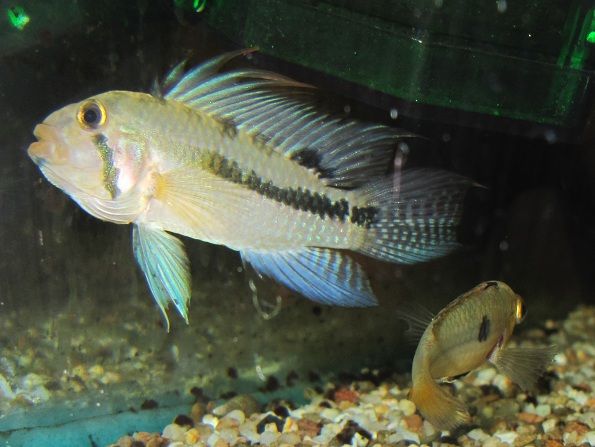
The male dead:
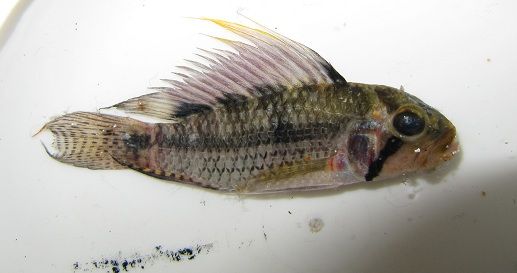
The female still alive, not feeling very well:
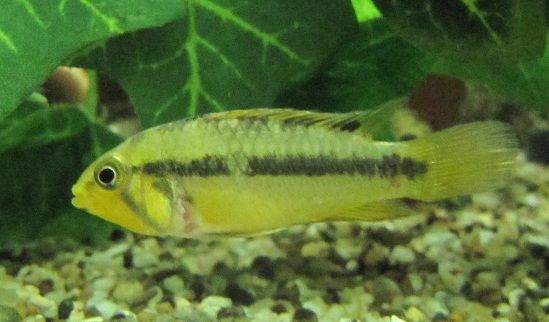
The female in breeding dress:
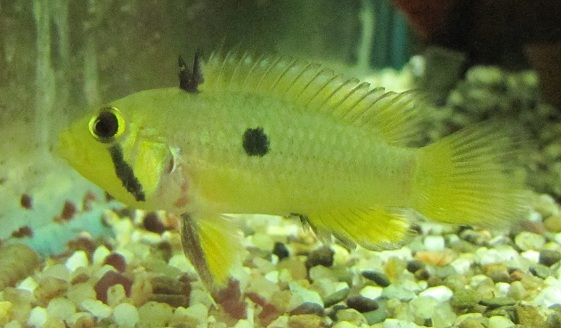
The female preserved in alcohol:
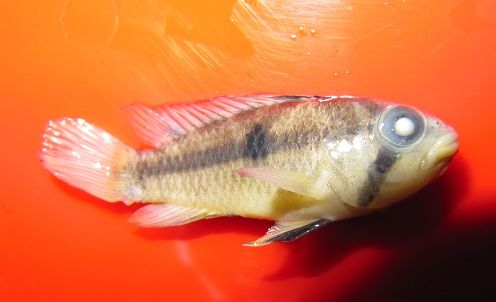
The young (see the dorsal spot):

Best,
Mark
Some time ago I posted a thread on what I was thinking a new species. See http://apistogramma.com/forum/index.php?threads/what-can-you-say-about-these.12574/#post-70980
In the months passed the female died and did not produce any new young. The male has lived for the last months but today he jumped out of his tank and did not survive. Therefor the story of this species is complete; I have a photo of the female in alcohol and a photo of the dead male. I have also added a photo of the young of these fish (now 1,5 cm).
The reason for me to say it is a new species is because of these signs/markings:
- both male and female show an obvious black spot at the end of the dorsal fin close to back of the fish. The only known species with such a spot is norberti. Norberti has no high dorsal fins in the male (at least not as much).
- the female has no black under the chin (no sp. Blackchin)
- the female shows no horizontal stripes under the lateral band (no cacatuoides)
Other caracteristics:
- the head and and mouth of the male (and female) are big and wide
- for the male the lateral band is separated from the caudal spot, for the female and the F1 this is less obvious.
- the dorsal fin of the male is high and the tips are red
- the caudal fin of the male has two tips and both (upper more) are red
- the male has two horizontal lines under the lateral band, but in his normal dress he doesn't show them; female has none.
- the normal dress for the female is one sidespot and the dorsal spot (the last is less visible)
- the first 1/3 of the lateral line of the male disappears when he is dominant
- the fish are found close to Leticia together with eunotus, bitaeniata and sp. Kelleri
- the fish were found by a Dutch group, who were also the first to find sp. Kelleri. This species was the bycatch of Kelleri, but in the commercial shipments of Kelleri the species has not turned up yet..
I hope this gives a complete image of the species. At this moment I have (only) 3 F1 fish and there are two pairs left in Holland with other aquarists. I hope these will give more young and maybe in the future this species will get caught again.
The male still alive:

The male dead:

The female still alive, not feeling very well:

The female in breeding dress:

The female preserved in alcohol:

The young (see the dorsal spot):

Best,
Mark